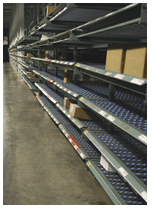The Death of the ‘Six Months Rule’ for Retail RFID Strategy
 Rapid progress of early-adopting retailers is stretching their headstart beyond the often cited six-month comfort zone
Rapid progress of early-adopting retailers is stretching their headstart beyond the often cited six-month comfort zone
By David Wyld, Contributing Editor
In Line56 Magazine, Tamina Vahidy recently observed that the Wal-Mart mandate has already effectively “changed the face of retail … making what had been a niche technology into a mainstream application.” Since 2004, Wal-Mart’s commitment to the technology has certainly been a driving force for the entire RFID market. And the well-reported work of the University of Arkansas’ RFID Research Center has shown the demonstrable impact of RFID at improving the mammoth retailer’s supply chain visibility and execution, dramatically reducing out-of-stocks, cutting back unnecessary orders, and improving the effectiveness of promotional efforts.
Recently, Wal-Mart’s CIO Rollin Ford pronounced that: “We continue to work with suppliers to help them see the vast potential of RFID. We’re already fully convinced of its value and are ready to step up the pace since we know we are only touching the tip of the iceberg when it comes to the benefits of this technology … We are actively engaged in designing some new initiatives that will accelerate our program even further and, in so doing, create even more value for everyone involved.”
Well, when it comes to RFID, retail executives are known to have an often unspoken “six month rule.” Plain and simple, many are willing to let the pioneers of the technology, like Wal-Mart, Target, Best Buy, and Metro take the arrows, expend the time and money, and learn the lessons about RFID. However, in reality, their mantra is “Don’t let me get more than six months behind Wal-Mart in RFID adoption.” Yet, as was recently written in Retailspeak Magazine, “the reality is that if you were waiting to hear Wal-Mart’s recent statement on RFID, you are already more than six months behind.”
Late last year, the retailer announced a significant acceleration of its RFID initiative, doubling both the number of suppliers – from 300 to 600 – that would be required to ship RFID-identifiable pallets and cases and the number of Wal-Mart stores – from 500 to 1,000 of its 3,900 stores – that would be RFID-enabled by January 2007. Moreover, after June 30, 2006, Wal-Mart had stopped allowing its participating suppliers from using GEN 1 technology, making them switch to EPC Gen 2 tags exclusively.
Writing in Directions Magazine on “The Strategic Implications of Wal-Mart’s RFID Mandate,” David H. Williams outlined what he called the “ripple effect” of the giant retailer’s initiative throughout the supply chain. Despite the immediate, short-term prevalence of “slap and ship” solutions and rather low RFID investments among Wal-Mart suppliers, Williams projects that suppliers will gravitate to using RFID tracking in their own operations and with their own suppliers upstream in the value chain. Likewise, with suppliers RFID-enabled, pressure will be exerted on transport carriers to use RFID-based tracking so that door-to-door visibility will be extended throughout the value chain. This “ripple effect” will serve to greatly multiply the numbers of companies impacted by the Wal-Mart mandate and cause sharply increased overall demand for RFID tags in the coming decade, which will further enable economies of scale in production of tags/smart labels and drive unit costs for RFID-based identification down.
As RFID tag/label prices drop, we will see a significant acceleration in the proliferation of tagging at the item level. The use of EAS (electronic article surveillance) tags in retail serves as a useful precedent. At present, there are six billion EAS tags produced annually at a price point of approximately one cent per unit. This represents marked growth over a few years ago, when the unit price was between five and eight cents and the market was one billion tags.
According to market projections for 2016 from Dr. Peter Harrop of IDTechEx, over half a trillion consumer items will be individually tagged, and the market for item-level tagging will exceed US$13 billion annually. As can be seen in Table 1, unique identification of consumer packaged goods (CPGs) will account for the vast preponderance of such item-level tagging. How will this impact individual companies? Take Altria, a leading consumer products manufacturer, for example. Altria has an exceptional stable of brands from its Kraft, Miller and Philip Morris units. If Altria were to individually tag each of items, this would amount to approximately 80 million tags annually for this company alone.

In sum, why is the much-heralded “Wal-Mart Way” becoming more and more RFID-enabled? In short, it is because the retailer’s RFID efforts are producing tangible results, both from an operational standpoint and for the retailer’s bottom-line. In the process, the retail giant is increasing revenue for participating supplier’s products by improving on-shelf availability and the sales velocity of the turnover of items. As RFID tagging proliferates and tag prices decline – especially in light of promising developments with non-silicon based tagging – we will see unprecedented opportunities for the retail supply chain to be interlinked. While mandates from large retailers around the world will continue to be important, suppliers and manufacturers will gravitate to earlier tagging – down to the item-level – to create a truly visible supply chain. Over time, we will see great benefits accrue to those firms that take the lead in innovating and discovering the future of RFID in consumer products. And, as the pace of change accelerates, six months will become a very, very long time in the retail market space. Those who follow the “six month rule” could find themselves out of pace with the new landscape of RFID-enabled retailing and be at risk, both operationally and strategically.
About the author:
David C. Wyld ([email protected]) is the Robert Maurin Professor of Management at Southeastern Louisiana University, where he directs the College of Business’ Strategic e-Commerce/e-Government Initiative and teaches business strategy.


